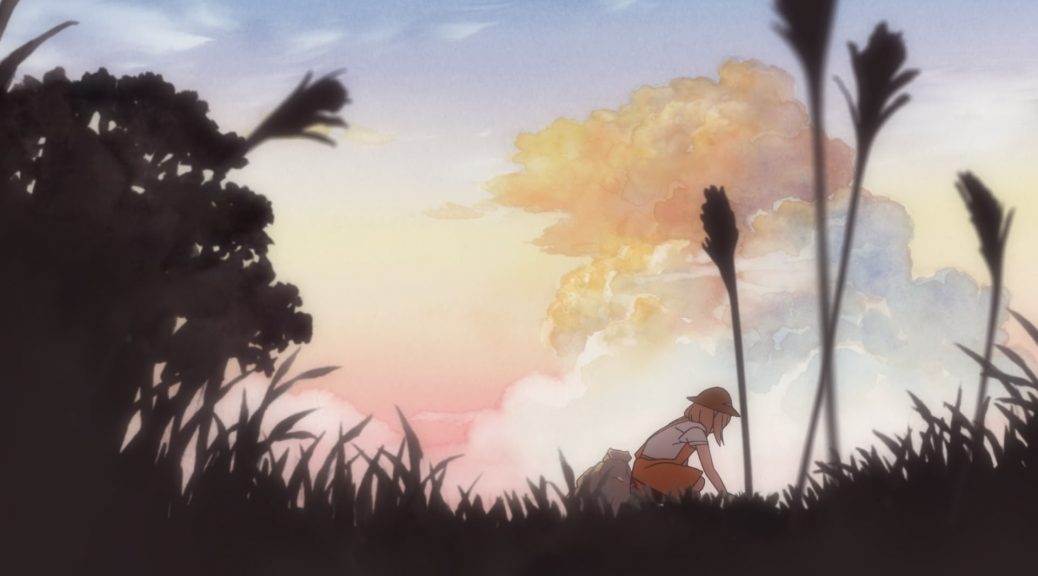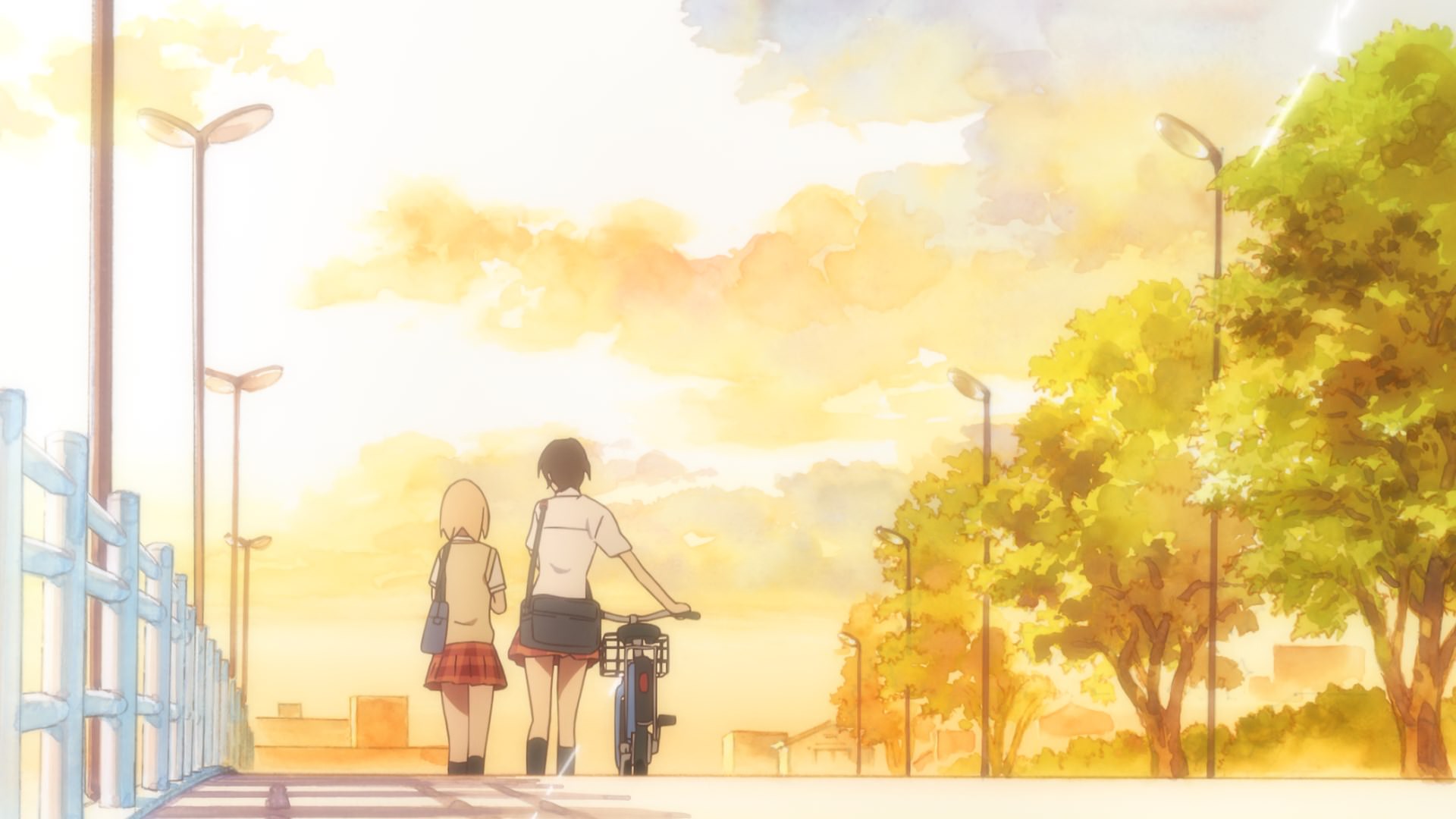
Kase-san and Morning Glories: A Couple’s Small Miracle
Asagao to Kase-san / Kase-san and Morning Glories’ very existence is a small miracle. A project that wasn’t meant to be, until a couple of people in particular fought for the chance to animate a sweet yuri manga they loved with such enthusiasm that it’s led to the existence of this wonderful theatrical OVA. It’s time to explain their struggles, the fascinating encompassing vision behind this piece, and the unusual set of influences that led to it – from a very ambitious anime studio to a US photographer!
Considering how unlikely of a project this is and the struggles a couple of people in particular had to go through to get it to happen, we’ve got to start by recapping the curious story of how it came to be. Director Takuya Sato happened to binge-read all the volumes of the manga available in the spring of 2016, immediately falling in love with the series and deciding that he wanted to make it into an anime at some point. In his excitement he recommended one of his friends and common work partners, who would go on to become the character designer and chief animation directorChief Animation Director (総作画監督, Sou Sakuga Kantoku): Often an overall credit that tends to be in the hands of the character designer, though as of late messy projects with multiple Chief ADs have increased in number; moreso than the regular animation directors, their job is to ensure the characters look like they're supposed to. Consistency is their goal, which they will enforce as much as they want (and can). of this title. However, that suggestion turned out to be a massive underestimation of how much Kumiko Sakai, known as Kyuta Sakai in the anime industry, adores yuri works; though the most popular titles she’s provided designs for are the likes of Re:Zero and Steins;Gate, it’s no coincidence that she handled series like Sakura Trick and Strawberry Panic as well. Whether it’s cute fluff or raunchy material, she’s always delighted to have an opportunity to draw intimate scenes between girls – we’re talking about the person who designed, supervised, and solo key animated an erotic OVA for A Kiss for the Petals after all. So of course, her reply to Sato’s Kase-san recommendation was a simple “Duh, that’s my favorite manga.” An amusing way for the core team to be assembled.
Enthusiasm alone can’t wish a project into existence however, and such a pure – in the genuine sense of the word, rather than awkward chastity – love story between girls wasn’t considered a title worth investing an important sum in. And so they had to first test the waters with a music video, revealed alongside a promotional clip in late March 2017 and first distributed on Youtube a couple of months later. The format wasn’t ideal for narrative purposes, but Sato was willing to do whatever it took to bring the work to life, and even saw positive sides to it; the possibility of distilling the series down to its essence had its own worth, and he valued the chance to gather a team almost entirely composed of fans of the original work, which isn’t feasible with the massive crews required for standard anime projects. Their work made the short film a very pleasant watch, as well as an effective way to gauge popularity not just in Japan but also overseas. The strong reception immediately allowed them to take the project further, and since Sato had always felt that this would be a good cinema experience, they began working on this 58 minute long theatrical OVA – a project so personal that it only credits director Sato and designer Sakai for its planning, as opposed to producers and executives as is standard.
And so, all that passion was channeled into an immensely charming yet odd work. Kase-san and Morning Glories is actually an episodic OVA covering three separate stories from the original comic, presented without much of an attempt to connect their narratives. Each segment has its own directorial staff to boot, though Sato’s overarching presence is by all means inescapable. In the end there isn’t much of a crescendo or a standard progression like what Doukyuusei threaded together despite having a sort of similar structure. Instead we see snippets of certain moments in a relationship and the collection of daily life scenes that surround them, which is a statement about this work in and of itself. 2018 turned out to be an exceptional year for theatrical anime following girls in love where storytelling is incidental rather than a goal to focus on.
After a very brief retelling of the music video, which was already a summary of how the two main characters started dating, we reach the first chapter that serves as an introduction to the dynamics between the couple; Yamada’s insecurities over her first relationship being with a much more popular and social girl like Kase, as well as the latter’s admiration of her girlfriend’s mundane tenacity and her plain cuteness. It’s all elegantly introduced through a bento-related incident, but again, it’s how their time together is brought to life that makes this adaptation stand out so much. The early phone conversation is the perfect embodiment of Hiromi Takashima’s lively art, without the restraints she had in a briskly paced manga. Cute expressions from single panels are expanded into elaborate sequences that articulate those relationship dynamics in elegant, adorable way. Technically impressive animation and eye-catching layouts, all without sacrificing the exaggeration that makes the source material’s art so appealing.
Although that scene might be the most brilliant one in that regard, it’s far from an exception. Studio ZEXCS’ commitment to animation starts with their fancy logo and stays strong throughout, even if it can’t maintain the consistent excellence you’d find in this industry’s best. While they’re no sakugaSakuga (作画): Technically drawing pictures but more specifically animation. Western fans have long since appropriated the word to refer to instances of particularly good animation, in the same way that a subset of Japanese fans do. Pretty integral to our sites' brand. powerhouse, it’s a common occurrence to see their projects go beyond what you would normally expect in terms of animation. 2016’s The Great Passage stands as the perfect example: a very grounded yet immensely ambitious character acting effort that did all it could despite not having all that many resources, sacrificing polish entirely if necessary. Kase-san is a much smoother effort, but you can still sense similar attitudes regarding acting. It’s noticeable right off the bat, since this first segment was presumably handled by ZEXCS animator Seishiro Nagaya – a regular staff member on The Great Passage, who has kept that spirit alive in later projects like this year’s Rokuhodo Yotsuiro Biyori. Considering he acted as storyboarder, director, assistant supervisor, key animator, and even in-betweener (a feat somehow still second to Sato’s own multi-tasking), it’s no surprise Nagaya could manage to leave his mark on this OVA.
This focus on articulate expression of mundanity ties back to the director’s approach to this title, but animation isn’t the only means through which they transmitted this sentiment. Among the multiple creators from diverse fields that Sato insisted the staff keep on their minds, late street photographer Saul Leiter left the biggest impression on the team. When conceptualizing the shots, Kase-san‘s staff shared very similar sensibilities: color as the protagonist, focus as means to highlight an instant of ordinary action, and daily life being shot through objects obstructing the view – which technically reduces the amount of information we receive, but at the same time tells us more. Even in climactic moments, there’s still a tendency to be more evocative than explicit in the layouts, giving it a mysterious aroma. Not all of Leiter’s mindset can easily carry over to animation, however. This medium has no such thing as natural spontaneity, since you can’t just instinctively record something you happened to come across, but the results of emulating it are still weirdly fascinating. I can’t help but smile at the fact that a cute yuri anime was so tangibly influenced by an American photographer born in the 1923, even more so when you realize it wasn’t an arbitrary decision in any way.
As we move onto the second part, it’s easy to notice how the staff merged two chapters: a visit to Yamada’s house and a school trip, joined by the shared themes of physical intimacy, sexual attraction, and the new set of insecurities born from those. According to the credit order, this was storyboarded by Kiyoko Sayama, the only woman in the team of directors (although under the supervision of Yasunari Nitta). Considering this is the segment that films the girls up close in their most vulnerable moments, the choice of material seems very deliberate. Unfortunately, it has the most insipid delivery by the admittedly very high standards of this OVA. It also struggles the most condensing down the narrative, which leads to some moments not earning the emotional weight they insist on carrying. Very few women have been spearheading entire projects in the anime industry for as long as Sayama, but even with her sizable experience in all sorts of productions this might have been too tricky of a task. A minor dip in quality on an otherwise still excellent piece.
If there’s one thing that stays consistently exceptional though, it’s got to be this OVA’s art direction. Kase-san’s beautiful backgrounds earn themselves a mention, not only due to the role they play in establishing its warm world but also because of what happened behind the scenes. Originally, the team contacted Yuka Hirama to act as the art directorArt Director (美術監督, bijutsu kantoku): The person in charge of the background art for the series. They draw many artboards that once approved by the series director serve as reference for the backgrounds throughout the series. Coordination within the art department is a must – setting and color designers must work together to craft a coherent world. for the music video and handle the backgrounds at Atelier Platz. Their work was fairly appealing and featured some striking shots, but lacked a unifying factor despite the short length of the piece. When it came time to produce the OVA, however, she was too busy with other projects like Mahou Shoujo Ore, so Kase-san had to switch art teams to Studio Wyeth, captained by Kazuyuki Hashimoto. It’s worth noting that Hirama’s ideas were respected, as she’s still credited for concept art, and her belief that the greenery needed special care because it represents Yamada’s dreams is still at the forefront. When it comes to the execution of those concepts though, the OVA offers something much more impressive. Gorgeous scenery that actually establishes its identity, and only increases its abstract side a tiny little bit when depicting memories so sweet they become hazy. Traditional paintings so bewitching that even the art director who got replaced to make way for them is dying for an opportunity to see the production materials.
The final segment arrives directly by the hand of director Takuya Sato, who had the troublesome task of nailing a very different mood while preventing this chapter from being at odds with the cohesive vision throughout. Back when they were making the original music video, he conveyed a strong keyword to the rest of the team: Only Light. His lasting impression from the manga was that there were no figurative shadows in this tale despite dealing with some harsh moments. And thus he wanted to translate that feeling very literally into his animation, as a way to preserve the cheerfulness it irradiated. That turned out to be quite tricky however, since his portrayal of lighting had always relied on techniques like strengthening the shadows to emphasize the strength of sunlight, for example. He figured out ways to always accentuate the brightness of the shots over their shadows, and that approach carried over to the OVA… to a degree. The lengthier format gave the team more time to focus on the anxieties of the characters, which naturally led to some darker scenes. There are some arresting shots that exploit this, but curiously, the most impactful moments might be a subtly gloomier classroom and a bit of rain. Contrast alone can pack immense power.
As his fans might be aware, Sato’s work has always had an unearthly quality to it, which his projects don’t always put to good use but that sometimes leads to captivating work like his ending sequence for Alice & Zouroku. And perhaps because of how much of a personal venture this was, Kase-san and this final chapter in particular might be his biggest success to date. Fantasy dyes the ordinary conflict without overpowering it, and the bitterness leaves a sweet aftertaste even before the earned happy end. Yamada and Kase deserved to be together just as much as this project deserved to be successful. A cute and pleasant series that couldn’t get an animated adaptation greenlit through normal means got made anyway, out of the sheer obstinacy of two people enamored with it. And rather than being content with that, they’ve kept on pushing the project forward, expanding the scope at each opportunity and transforming the story they loved into something very special. Kase-san and Morning Glories turned out to be quite different from its comic counterpart, a perfect companion piece that is in no way of inferior quality. Don’t let this one slip past you.
Staff
Director, Scriptwriter, Sound Director: Takuya Sato
StoryboardStoryboard (絵コンテ, ekonte): The blueprints of animation. A series of usually simple drawings serving as anime's visual script, drawn on special sheets with fields for the animation cut number, notes for the staff and the matching lines of dialogue.: Seishiro Nagaya, Kiyoko Sayama, Takuya Sato
Unit Direction: Seishiro Nagaya, Yasunari Nitta, Takuya Sato
Chief Animation DirectionAnimation Direction (作画監督, sakuga kantoku): The artists supervising the quality and consistency of the animation itself. They might correct cuts that deviate from the designs too much if they see it fit, but their job is mostly to ensure the motion is up to par while not looking too rough. Plenty of specialized Animation Direction roles exist – mecha, effects, creatures, all focused in one particular recurring element.: Kyuta Sakai
Animation DirectionAnimation Direction (作画監督, sakuga kantoku): The artists supervising the quality and consistency of the animation itself. They might correct cuts that deviate from the designs too much if they see it fit, but their job is mostly to ensure the motion is up to par while not looking too rough. Plenty of specialized Animation Direction roles exist – mecha, effects, creatures, all focused in one particular recurring element.: Yasunari Nitta, Sakae Shibuya, Hiroichi Sato, Tomoko Sudo
Assistant Animation Director: Daisuke Kitagawa, Seishiro Nagaya, Yuki Miyazawa, Tomoko Sugimoto, Rumi Abeshima, Takumi Yokota, Kazuya Morimae, Tsutomu Miyazawa, Takahiro Sasaki
Art DirectorArt Director (美術監督, bijutsu kantoku): The person in charge of the background art for the series. They draw many artboards that once approved by the series director serve as reference for the backgrounds throughout the series. Coordination within the art department is a must – setting and color designers must work together to craft a coherent world.: Kazuyuki Hashimoto
PhotographyPhotography (撮影, Satsuei): The marriage of elements produced by different departments into a finished picture, involving filtering to make it more harmonious. A name inherited from the past, when cameras were actually used during this process. Director: Takeshi Kuchiba
Key AnimationKey Animation (原画, genga): These artists draw the pivotal moments within the animation, basically defining the motion without actually completing the cut. The anime industry is known for allowing these individual artists lots of room to express their own style.: Yuki Hamada, Chika Yoshimi, Miyako Yatsu, Ayumi Ikeda, Ryo Kodama, Chiho Fujiwara, Masato Nishikawa
Yoshiaki Ikeya, Akihiro Otake, Takao Takegami, Miyuki Abe, Toshimasa Kuroyanagi, Tatsunori Inatsu, Rina Nagai, Takaki Inoue, Mariko Goto, An Katsuragi, Yui Soeda, Kazuya Komiyama, Noriko Shimazawa
Takayuki Gotan, Aya Nakanishi, Kanako Ueda, Shigeru Kimishima, Toshiyuki Sato, Hiroki Harada, Atsuko Takahashi, Takashi Igari, Noboru Kawamori
mebachi, Hiroichi Sato, Daisuke Kitagawa, Tomoko Sugimoto, Rumi Abeshima, Tomoko Sudo, Seishiro Nagaya, Takuya Sato
Support us on Patreon to help us reach our new goal to sustain the animation archive at Sakugabooru, SakugaSakuga (作画): Technically drawing pictures but more specifically animation. Western fans have long since appropriated the word to refer to instances of particularly good animation, in the same way that a subset of Japanese fans do. Pretty integral to our sites' brand. Video on Youtube, as well as this SakugaSakuga (作画): Technically drawing pictures but more specifically animation. Western fans have long since appropriated the word to refer to instances of particularly good animation, in the same way that a subset of Japanese fans do. Pretty integral to our sites' brand. Blog. Thanks to everyone who’s helped out so far!



love hearing about sakai’s involvement with the project because the very first thing i thought upon seeing her credits for the first time was “oh so she’s worked on all the gay shit”. i’m a fan now
also oh, i didn’t notice that mebachi did key animation here! that’s cool
anyway good post lad thanks
Sakai is, as the kids say, a literal gaylord but in the best of ways. She might be the happiest person about this whole ordeal.
And yeah, mebachi did a tiny bit of animation! She got credited in the last group of KA alongside the key staff, though her contribution isn’t actually very substantial – she just animated the handful of short new cuts in the opening sequence. She’s acquainted with Sato so that might be the reason she made this brief appearance. Appreciated nonetheless!
thank you for this write-up, it’s very important for people to know just how much work has do be put in for stuff like this to be made, even if it has so obviously great source material.